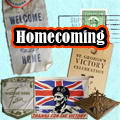Home | Homecoming | Coming Home | Family Reunification
Family Reunification
Trains carrying hundreds of servicemen and women arrived at stations across Alberta to tumultuous fanfare and emotional welcomes. Station platforms were packed with parents, wives, girlfriends, and children all waving and cheering wildly, overcome with emotion.
Husbands and wives embraced, many for the first time in years. Mothers and fathers welcomed home their sons, now grown men, mature and hardened from their experiences overseas, and in some cases hardly recognizable in comparison to the youthful looking boys that left home at the beginning of the war. Young children scanned the crowd, photographs in hand, searching for fathers they scarcely remembered.
 Amid these celebrations was the stark realization that some husbands, sons, brothers and uncles would never return home. Canada suffered nearly 45,000 casualties during the Second World War leaving many wives and children to move on with their lives without a husband or a father.
Amid these celebrations was the stark realization that some husbands, sons, brothers and uncles would never return home. Canada suffered nearly 45,000 casualties during the Second World War leaving many wives and children to move on with their lives without a husband or a father.
When asked what they expected of postwar life, servicemen without families expressed a desire to marry and have children. Married men were keen on starting families or having more children. Those children born between the late 1940s and early 1960s are referred to as the "baby boom generation" and are a direct consequence of the sentiments stated above.
Returning soldiers strove for a return to normalcy. Most importantly, they wanted to spend time with their family and return to the workforce. While work and career were important, the first order of business was often marriage. Some fiancées had waited several years, since 1939 or earlier. Marriage was also important to service personnel for it was a joyous occasion and represented a return to stability and normalcy -- a sharp contrast to the events these individuals had experienced daily during the war.
In most instances husbands returned to the workforce while their wives left their jobs and resumed their traditional, domestic responsibilities. Not all women were keen to forego their newfound status as working women and “breadwinners”. The war had resulted in hardships, but it was also a period of opportunity and liberation from the status quo for women.In rural communities, husbands and fathers were in need of reliable partners and helping hands rejoin them in the operation of the farm; they pressed their wives and grown daughters to quit leave their jobs to return to their pre-war roles.








